Disturbing trend at major banks greatly affects many Australians
By
VanessaC
- Replies 54
The Australian banking landscape is undergoing a significant transformation, and it's not all good news for consumers, especially those in regional areas.
A worrying trend has emerged among the country's major banks, including Commonwealth Bank, National Australia Bank (NAB), and Australia and New Zealand Banking Group (ANZ), which could have far-reaching implications for Australians.
The number of bank-owned ATMs has been cut by more than half since 2017, and bank branches have also seen a significant decline.
This trend is causing concern among politicians and consumers alike, who fear it could lead to Australia becoming a cashless society.
According to data compiled by the Australian Prudential Regulation Authority, the number of bank-owned ATMs has plummeted from 13,814 in 2017 to just 5,693.
Over the same period, the number of bank branches has decreased from 5,694 to 3,588.
This decline is happening despite major banks like Commonwealth Bank reporting substantial profits.
Earlier this February, the bank announced a half-yearly profit of $5 billion, only slightly down from its previous six-month record result.
Liberal Senator Jonathon Duniam has voiced his concern over this trend, arguing that banks are failing regional Australians by not keeping their ATMs functional.
'Frankly it’s probably cost-cutting measures on the part of banks that I find very disappointing,' he said.
'I think these organisations that make significant profits should be required to maintain these facilities in regional communities.'
'I’ve got nothing against profits but delivering on these services to communities is critically important.'
'They’ve closed the branches. ATMs are a much cheaper alternative. Please keep them particularly in regional communities and big cities too.'
Senator Duniam also highlighted the dangers of an over-reliance on electronic transactions.
He recalled the recent mass outage of the Optus network in November, which rendered many EFTPOS machines useless.
'What do we do if we don’t have ATMs?' he asked.
'If people aren’t using cash, if shops won’t accept cash we are going to be a bit stuck.'
The senator also noted that many elderly people are uncomfortable with electronic transactions, further underscoring the need for maintaining cash access.
Banks have defended their decision to close branches and ATMs by pointing out that fewer customers are using these services.
By the end of 2022, cash only accounted for 13 per cent of Australian consumer payments, compared to 70 per cent in 2007.
Last December, Reserve Bank Governor Michele Bullock suggested that businesses should charge fees to Australians who use cash. While she admitted such a move was unlikely due to potential backlash, she argued that from an economist's point of view, it was justifiable.
'As economists you want people to face the prices of using particular services that reflect the cost of those services,' Ms Bullock said.
LNP Senator Gerard Rennick, who initiated and sits on a Senate committee conducting an inquiry into bank closures, responded by saying Ms Bullock was 'way out of touch' for suggesting the idea.
He was adamant that Australians should never have to pay extra to use cash.
He also accused Ms Bullock of losing sight of her area of responsibility.
'She should be representing the interests of the Australian people,' Senator Rennick said.
 What are your thoughts on this trend? Have you been affected by the closure of ATMs or bank branches in your area? Share your thoughts and experiences in the comments below.
What are your thoughts on this trend? Have you been affected by the closure of ATMs or bank branches in your area? Share your thoughts and experiences in the comments below.
A worrying trend has emerged among the country's major banks, including Commonwealth Bank, National Australia Bank (NAB), and Australia and New Zealand Banking Group (ANZ), which could have far-reaching implications for Australians.
The number of bank-owned ATMs has been cut by more than half since 2017, and bank branches have also seen a significant decline.
This trend is causing concern among politicians and consumers alike, who fear it could lead to Australia becoming a cashless society.
According to data compiled by the Australian Prudential Regulation Authority, the number of bank-owned ATMs has plummeted from 13,814 in 2017 to just 5,693.
Over the same period, the number of bank branches has decreased from 5,694 to 3,588.
This decline is happening despite major banks like Commonwealth Bank reporting substantial profits.
Earlier this February, the bank announced a half-yearly profit of $5 billion, only slightly down from its previous six-month record result.
Liberal Senator Jonathon Duniam has voiced his concern over this trend, arguing that banks are failing regional Australians by not keeping their ATMs functional.
'Frankly it’s probably cost-cutting measures on the part of banks that I find very disappointing,' he said.
'I think these organisations that make significant profits should be required to maintain these facilities in regional communities.'
'I’ve got nothing against profits but delivering on these services to communities is critically important.'
'They’ve closed the branches. ATMs are a much cheaper alternative. Please keep them particularly in regional communities and big cities too.'
Senator Duniam also highlighted the dangers of an over-reliance on electronic transactions.
He recalled the recent mass outage of the Optus network in November, which rendered many EFTPOS machines useless.
'What do we do if we don’t have ATMs?' he asked.
'If people aren’t using cash, if shops won’t accept cash we are going to be a bit stuck.'
The senator also noted that many elderly people are uncomfortable with electronic transactions, further underscoring the need for maintaining cash access.
Banks have defended their decision to close branches and ATMs by pointing out that fewer customers are using these services.
By the end of 2022, cash only accounted for 13 per cent of Australian consumer payments, compared to 70 per cent in 2007.
Last December, Reserve Bank Governor Michele Bullock suggested that businesses should charge fees to Australians who use cash. While she admitted such a move was unlikely due to potential backlash, she argued that from an economist's point of view, it was justifiable.
'As economists you want people to face the prices of using particular services that reflect the cost of those services,' Ms Bullock said.
LNP Senator Gerard Rennick, who initiated and sits on a Senate committee conducting an inquiry into bank closures, responded by saying Ms Bullock was 'way out of touch' for suggesting the idea.
He was adamant that Australians should never have to pay extra to use cash.
He also accused Ms Bullock of losing sight of her area of responsibility.
'She should be representing the interests of the Australian people,' Senator Rennick said.
Key Takeaways
- ATMs in Australia have decreased substantially since 2017, with numbers cut by more than half.
- Senator Jonathon Duniam advocated for banks to maintain ATM services, particularly in regional areas, and criticised bank cost-cutting measures despite their significant profits.
- Concerns have been raised about the potential challenges and risks of a cashless society, especially for those uncomfortable with electronic transactions, such as many elderly people.
- There are differing opinions on whether businesses should charge for cash transactions, with Reserve Bank Governor Michele Bullock suggesting it could be justified, while Senator Gerard Rennick strongly opposes extra fees for using cash.








